
The Bottom Line
Introduction, Specifications, and Pricing
Many X299 motherboards we review cost well over $200, but not the ASRock X299 Extreme4. The new motherboard has one purpose; to make the X299 platform affordable.
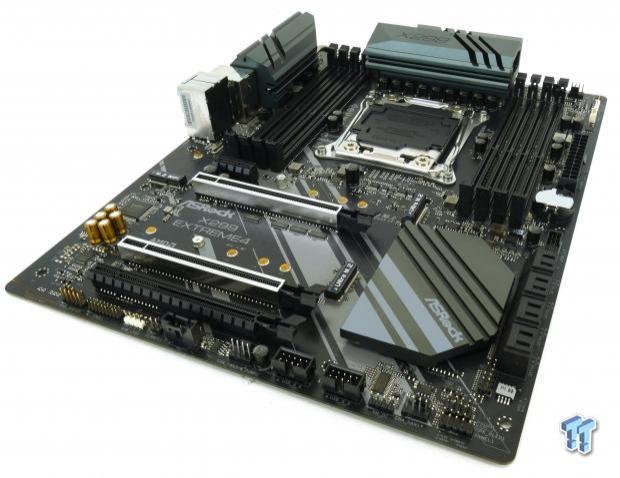
The biggest barrier to entry of the X299 platform is price, and ASRock is looking to shake things up by providing a low cost but reliable product with basic platform features. ASRock is known for making waves with fairly priced loaded products, so let's see how this one does.
Specifications

The X299 Extreme4 offers a lot of features including Intel LAN, two Ultra M.2 slots, USB 3.1, SATA6Gb/s, USB 3.0, and even RGB LEDs.
Pricing
The X299 Extreme4 costs $199.99.
Packaging and X299 Extreme4 Overview
Packaging and Overview
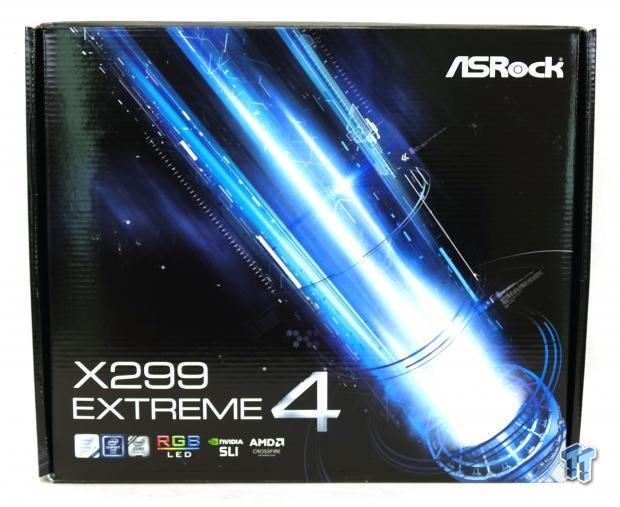
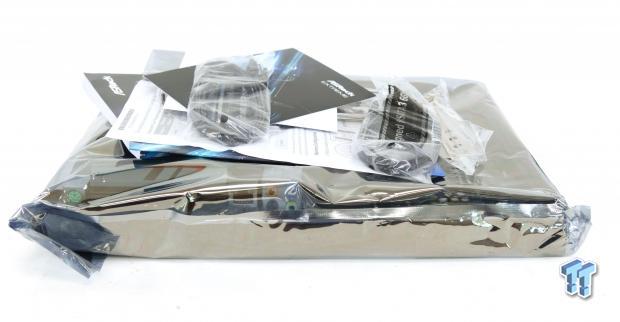
Packaging was kept very simple to cut down costs, but it doesn't invalidate motherboard protection. The motherboard still comes in an anti-static foam tray and bag.
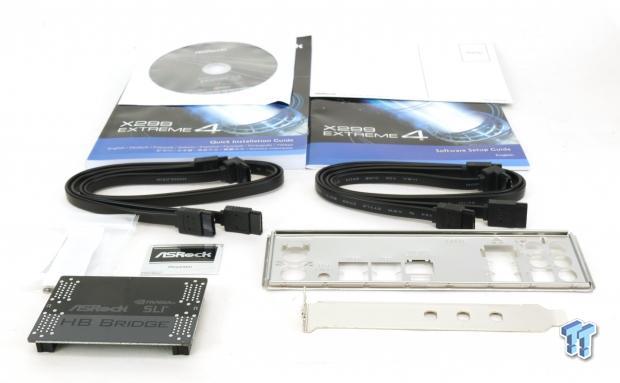
The accessory package includes four SATA6Gb/s cables, WIFI antenna bracket, SLI HB bridge, IO shield, case badge, M.2 screws, manuals, postcard, and driver DVD.
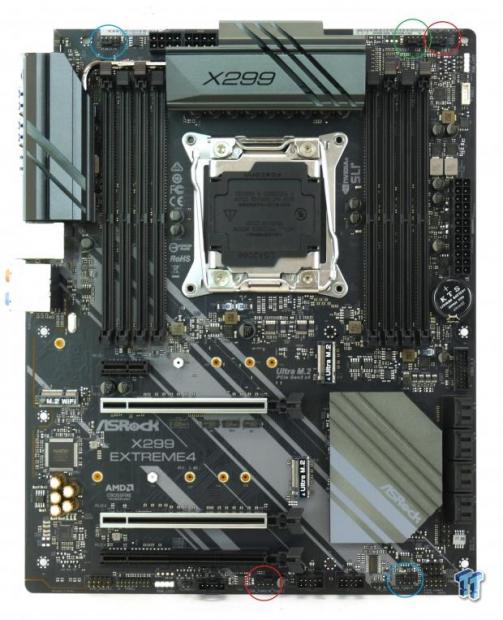
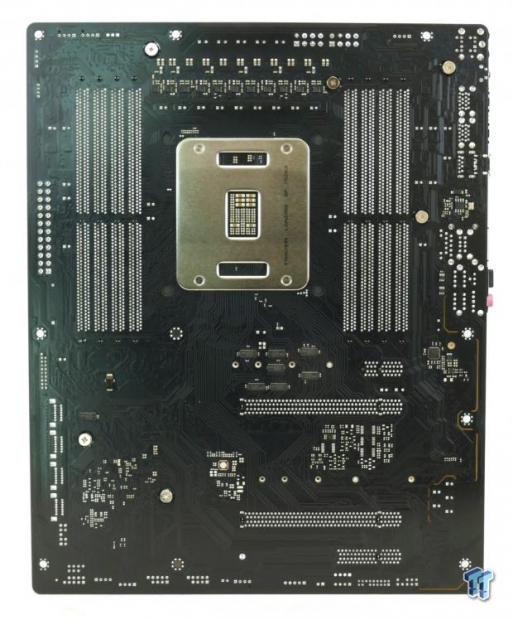
ASROCK put five fan headers on the X299 Extreme4, which is standard for ASRock motherboards. All headers but the CPU fan header circled in green can auto-detect if a PWM or DC mode fan is used and will change their mode accordingly. You can manually change their modes through the UEFI or Windows.
The two headers circled in red are also pump headers, meaning they should run full speed by default and they also support up to 1.5A. The CPU fan header (and I believe the two headers circled in blue) are rated to 1A maximum. The motherboard's color theme is straightforward and dark, something many people like. The back of the motherboard has a few components, but not too many.

The rear IO panel features PS/2 keyboard, PS/2 mouse, Clear CMOS button, four USB 3.0 ports, USB 3.1 type-A, USB 3.1 type-C, two USB 2.0 ports, 1Gbit LAN, and 7.1 audio outputs with S/PDIF out.
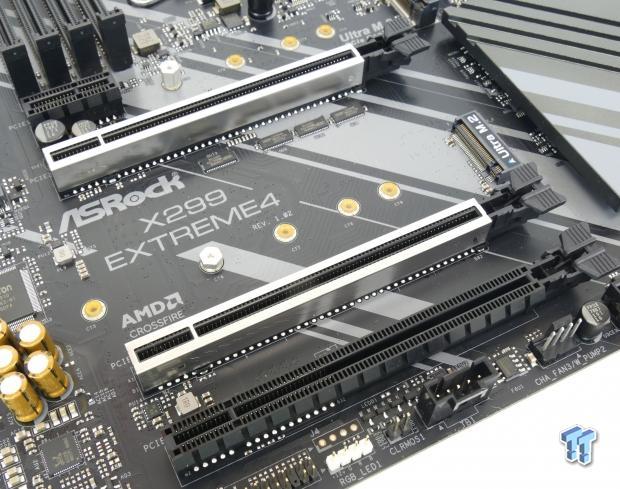
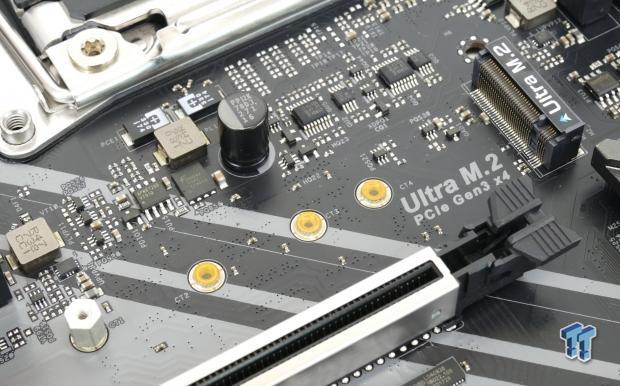
The PCI-E lane allotment is interesting, as it's significantly different than that of other X299 motherboards. From top to bottom the three x16 slots operate at x16/x16/x4 at all times with a 44-lane CPU. With a 28-lane CPU, they operate at x16/x8/x4. With a 16-lane CPU, they operate at x16/x0 or x8/x8 and the last x16 slot will route to the PCH. The top M.2 slot is x4 PCI-E 3.0 and supports SATA based drives too, if you use this slot then SATA port 0 is disabled. I am not sure if the M.2 slot is routed to the PCH or CPU.
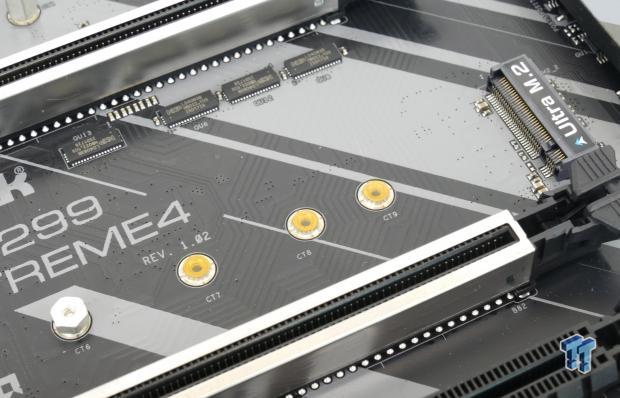
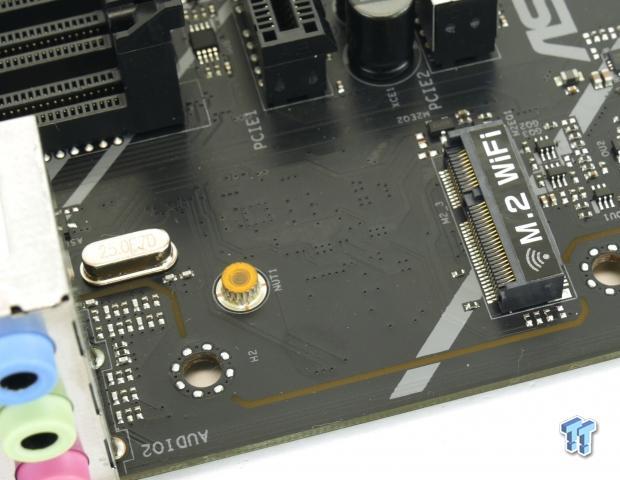
The second M.2 slot is x4 PCI-E 3.0 and supports SATA drives, and if you use a SATA drive SATA port 1 will be disabled. I am not sure if the PCH or CPU provide bandwidth to the M.2 slot. There is also an M.2 slot for WIFI modules; it will disable PCI-E slot 1 (the topmost x1 slot) if it's used and vice versa.
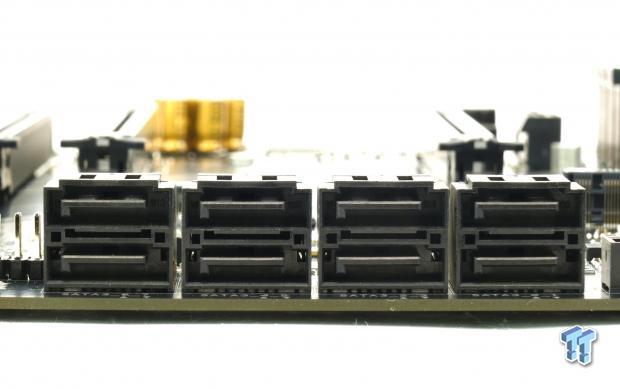
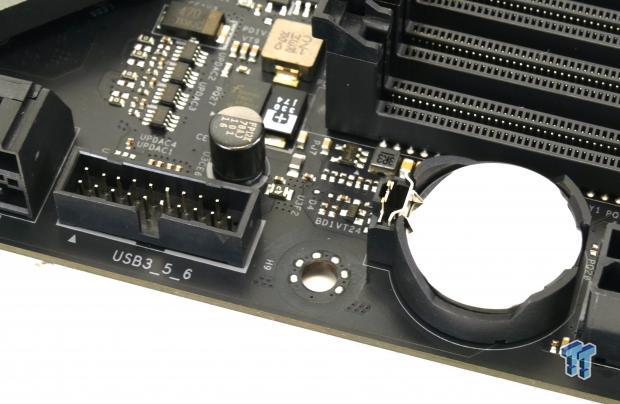
Eight SATA6Gb/s ports are routed to the PCH. A single USB 3.0 internal header can be found under the CMOS battery under the 24-pin connector.
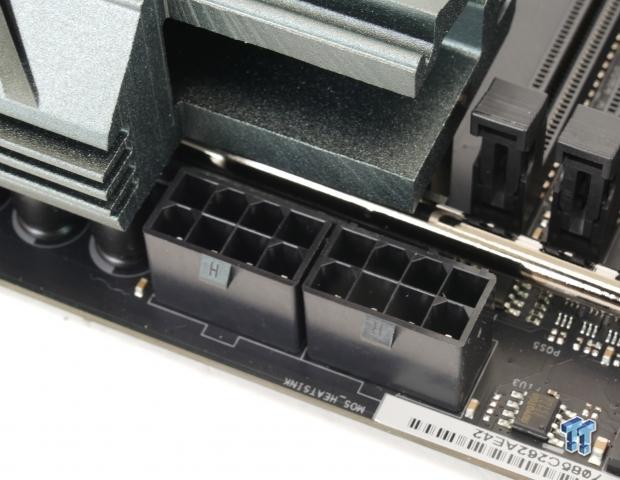
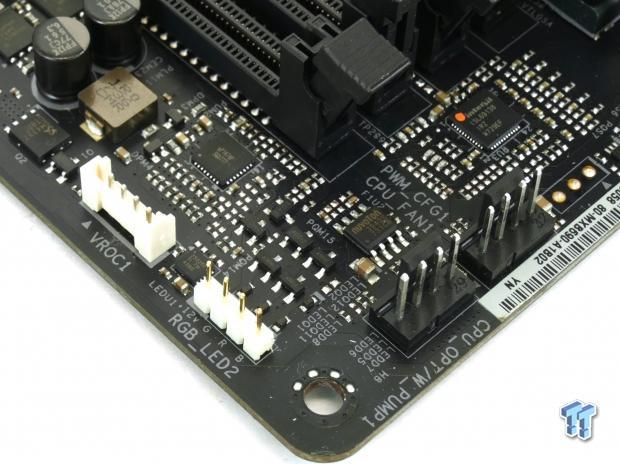
The motherboard does feature two 8-pin CPU power plugs. In the top right corner of the motherboard, we find the VROC key and an RGB LED header.
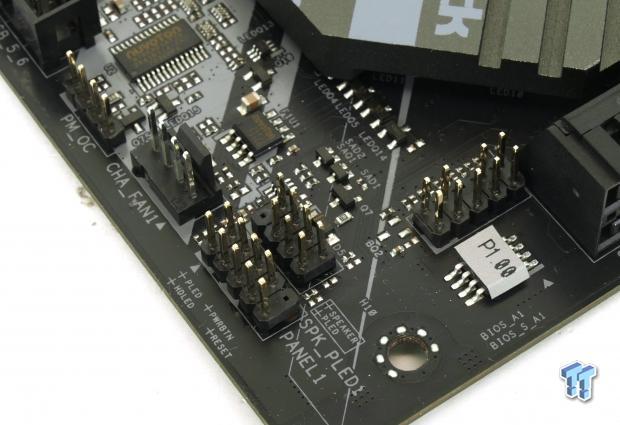
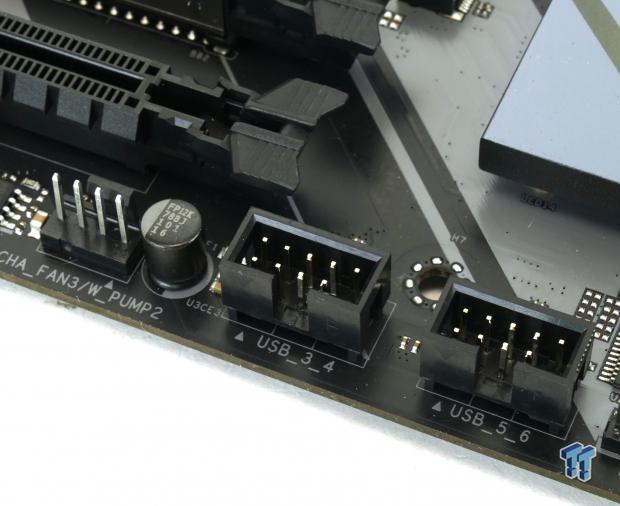
In the bottom right corner of the motherboard we find out front panel headers, but to their left, we have a PM_OC header. The header can be attached to an LED and a button to enable or disable an auto overclock. There are two USB 2.0 internal headers under the PCH area.
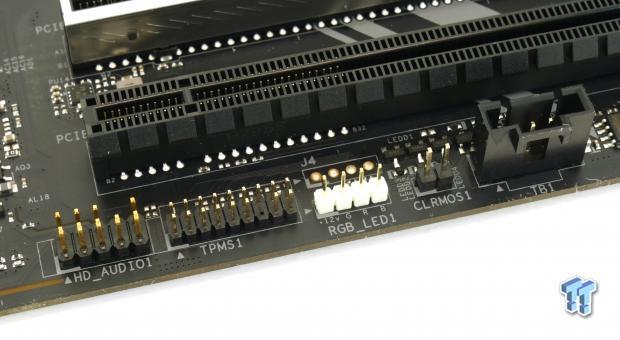
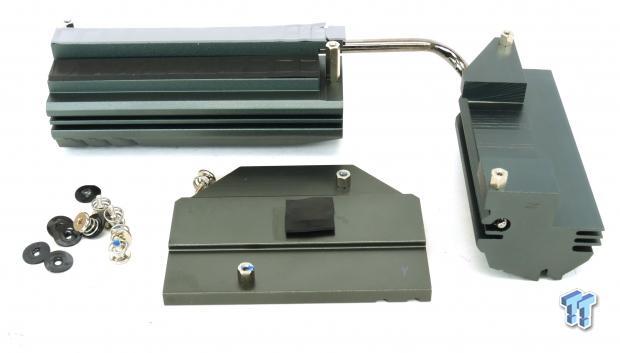
Another RGB LED header is sandwiched between a TPM header and clear CMOS header near a ThunderBolt GPIO header. The CPU VRM heat sink is a real beast, it has a lot of weight and should do a decent job of cooling the VRM.
ASROCK X299 Extreme4 Circuit Analysis
Circuit Analysis
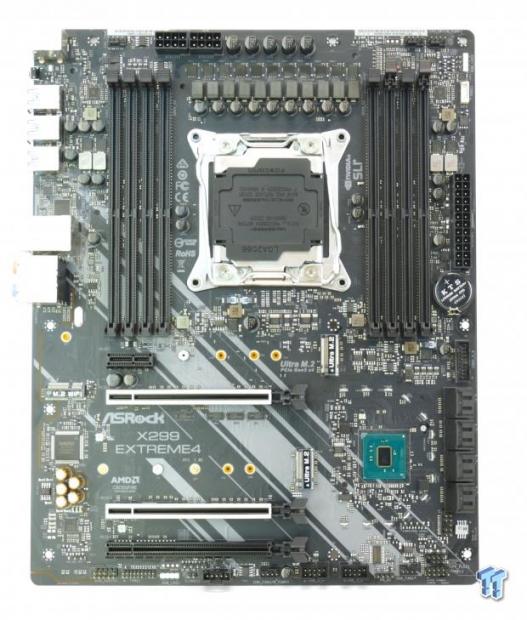
Let's see what the motherboard is hiding under its heat sinks.


The CPU VRM is in a 10+1 phase configuration, and it uses Intersil's brand new digital PWM the ISL69138, which offers up to 7 phases in flex mode. It is in a five-phase mode and doubled to 10 by adding two drivers on each PWM signal. Each phase uses a 60A inductor along with a Fairchild Semiconductor FDPC5030 PowerTrench Power Clip dual N-channel MOSFET, each rated for 25A. The VCCSA is also controlled by the CPU VRM PWM controller, so it's in 5+1 phase mode.
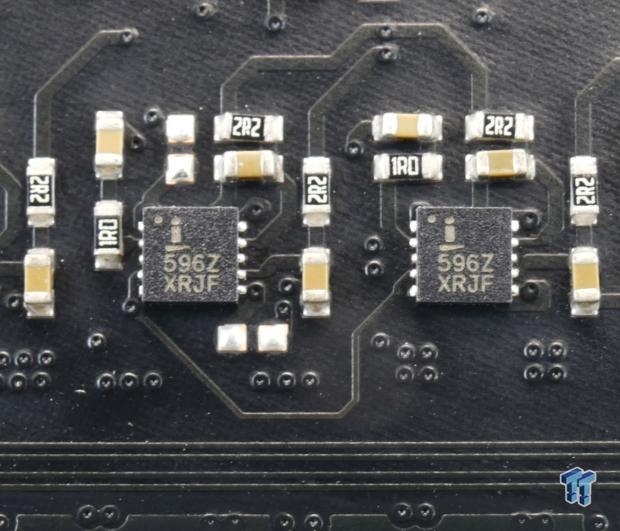
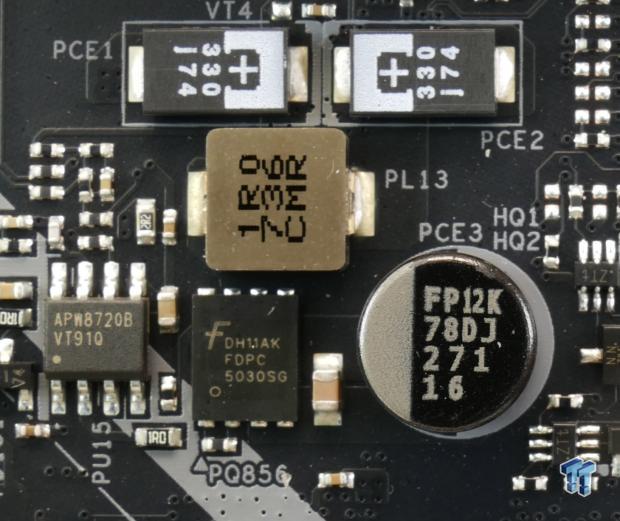
We also find that each phase gets an Intersil ISL6596 MOSFET driver located on the rear of the PCB, and we can see that every two drivers have their PWM inputs tied together, effectively doubling phase count from 5 to 10. The VCCIO uses a single phase VRM with an Anpec APW8720 PWM with integrated driver along with one Fairchild FDPC5030.
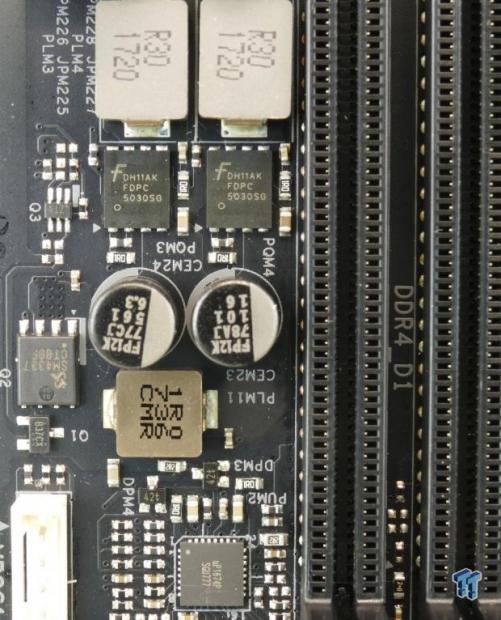
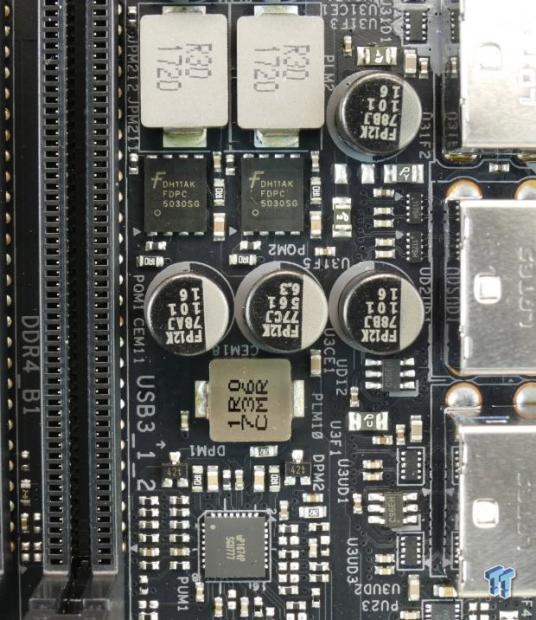
Each memory VRM uses two Fairchild FDPC5030 in two phases, and each is controlled by a UPI uP1674 PWM controller with integrated drivers.
ASROCK X299 Extreme4 Circuit Analysis Continued
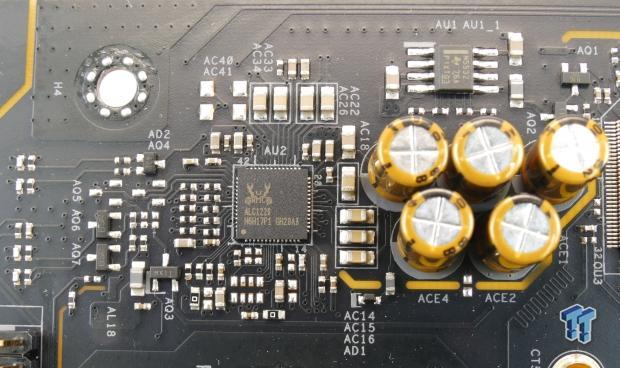
We find a Realtek ALC1220 codec along with a Texas Instruments NE5532 amplifier, and Gold series audio capacitors and physical PCB isolation help to improve overall audio signal quality.
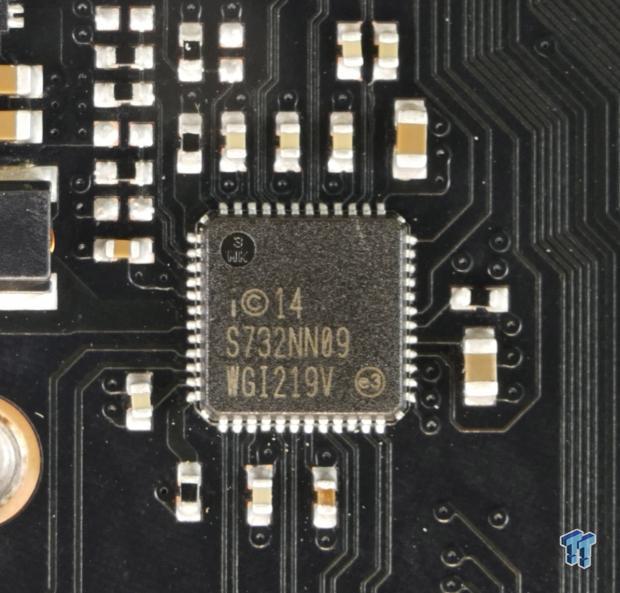
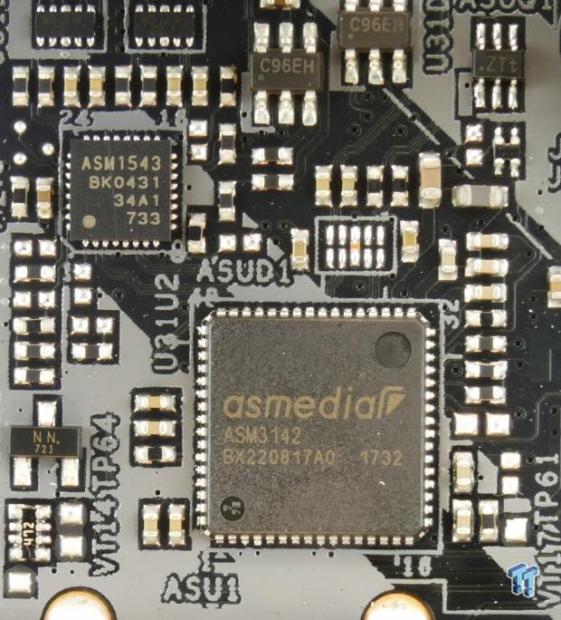
The motherboard uses the Intel i219v PHY to produce a fully functioning 1Gbit NIC. An ASMedia ASM3142 and ASM1543 provide the rear USB 3.1 type-A and type-C ports.
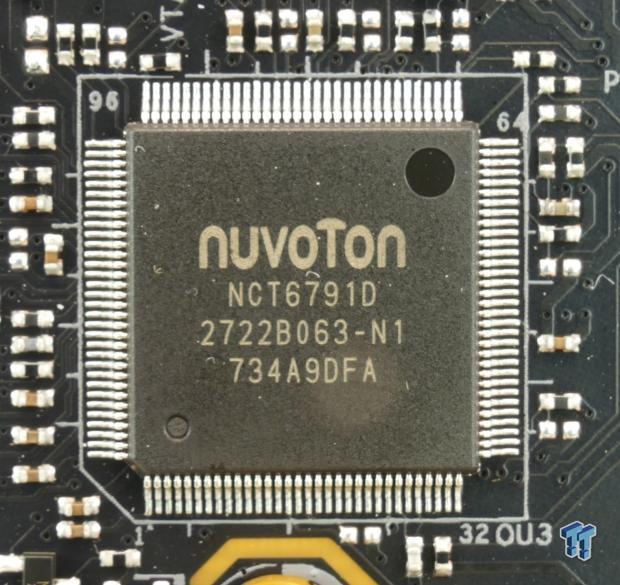
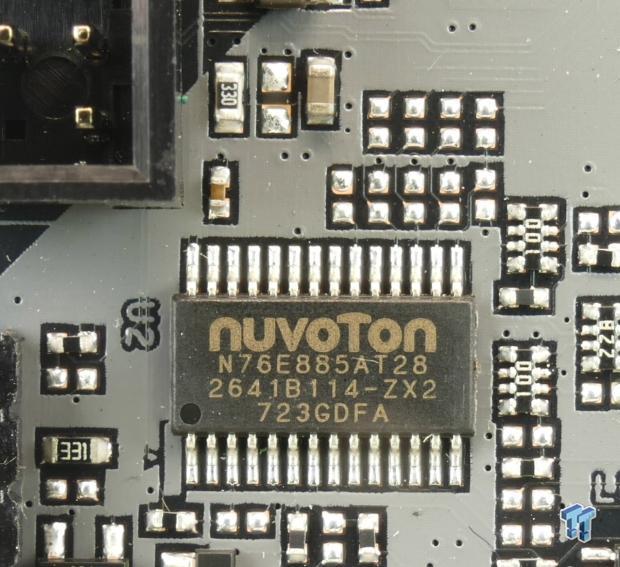
The main SuperIO is the NCT6791D, and a Nuvoton N76E88AT provides RGB LED support.
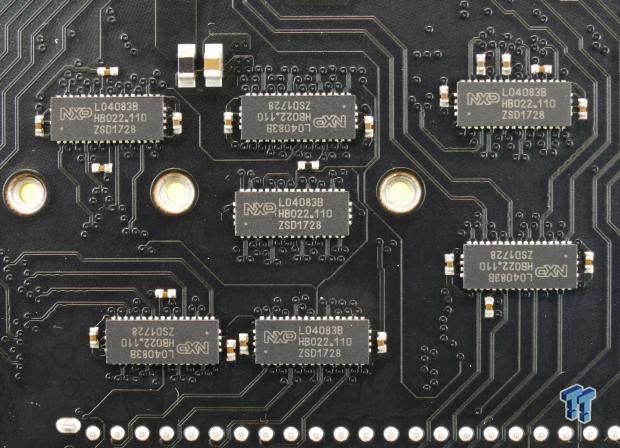
There are multiple NXP switches on the rear of the rear of the motherboard; each moves x2 PCI-E 3.0. Although the slot bandwidth is pretty much fixed, these are required because the pin outs for the Skylake-X and Kaby Lake-X CPUs differ in regards to the PCI-E lanes.
BIOS and Software
BIOS
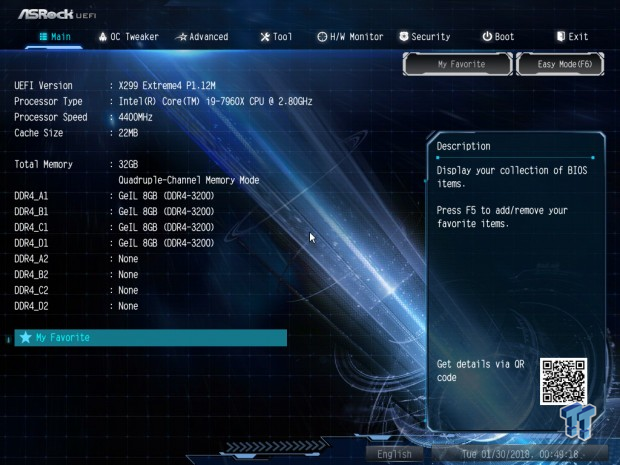
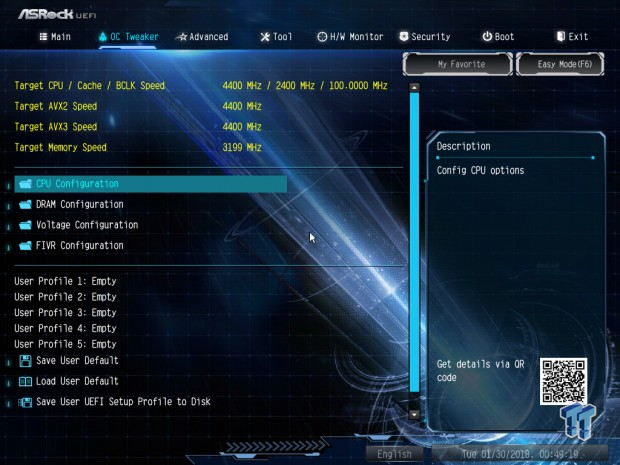
ASRock's new UEFI is basically the same as their older UEFI. They are using the same high-end layout, and all overclocking features are present. Fan control is present through a menu system and through a GUI. RGB LED control is also present in the UEFI. Oddly enough, even though the slots are pretty much hard set in regards to what they do and how they support bandwidth, you can reduce either of the x16 slots into x4/x4/x4/x4 for a breakout card.
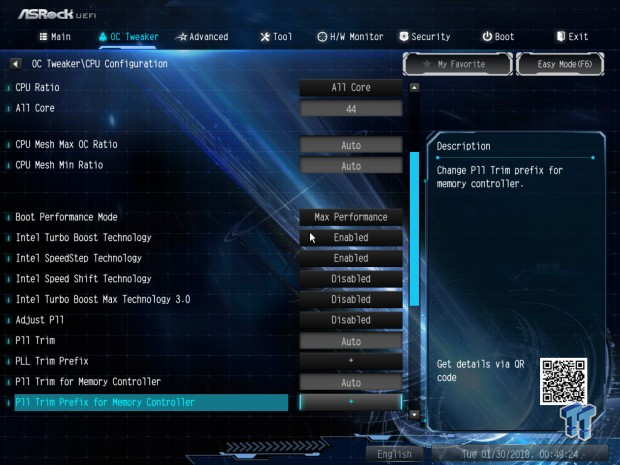
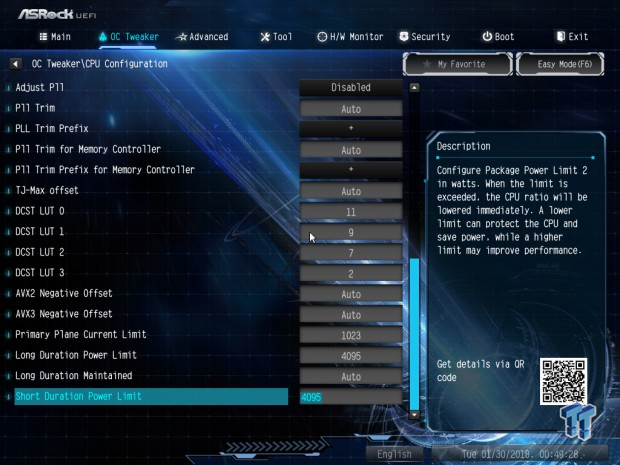
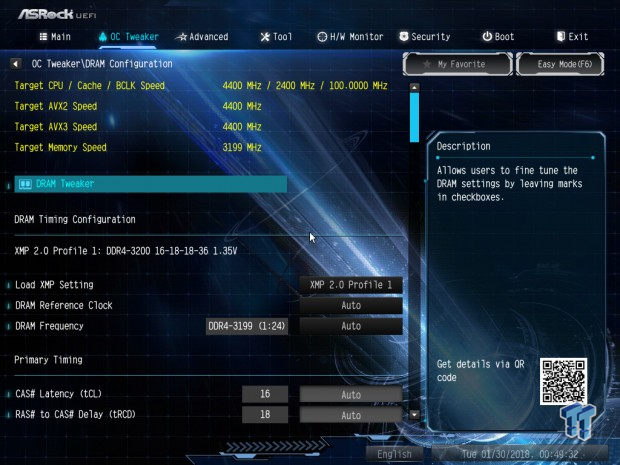
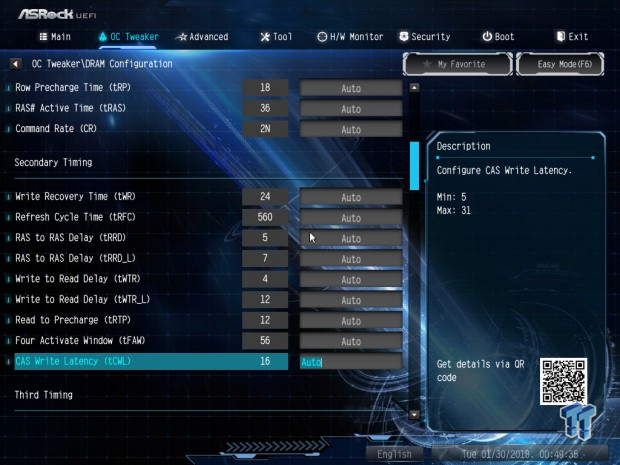
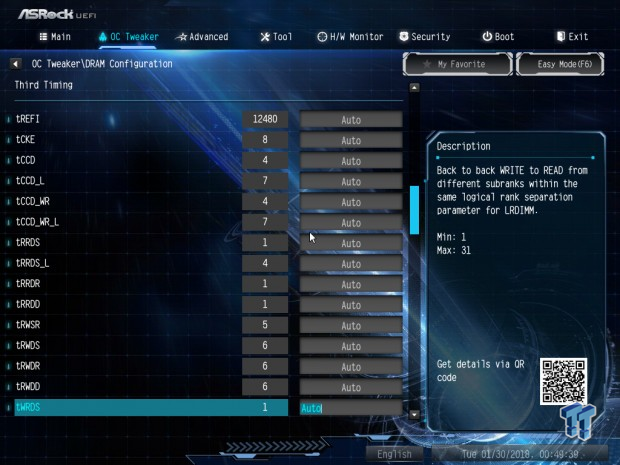

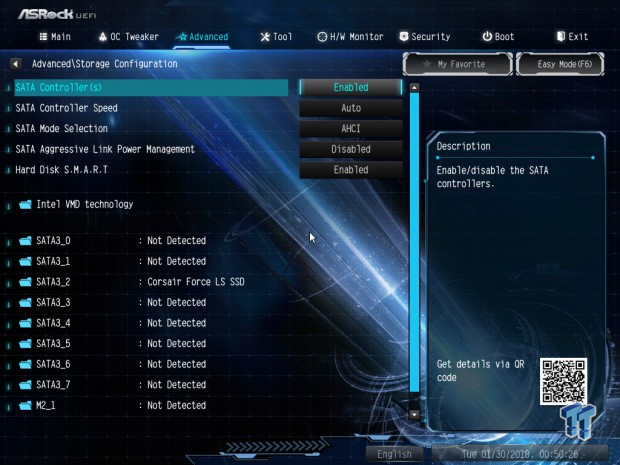
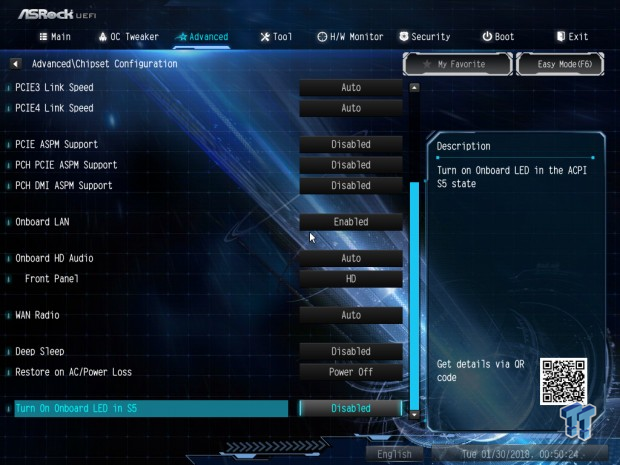
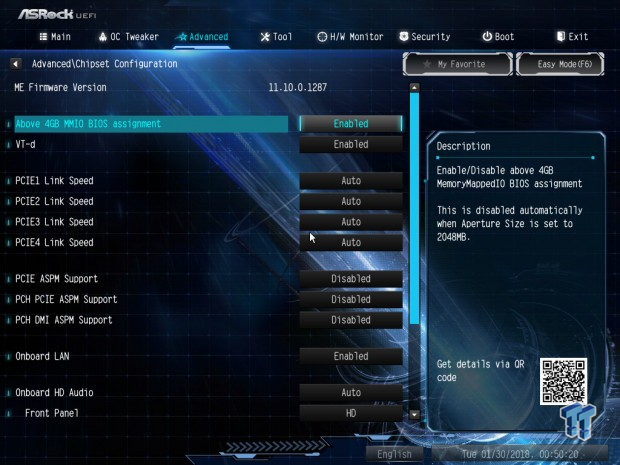
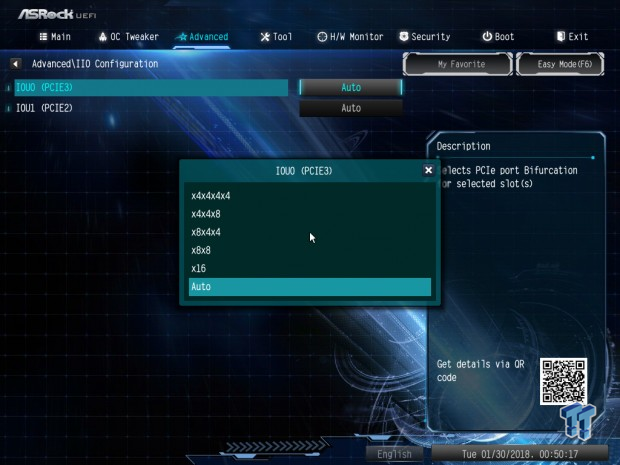


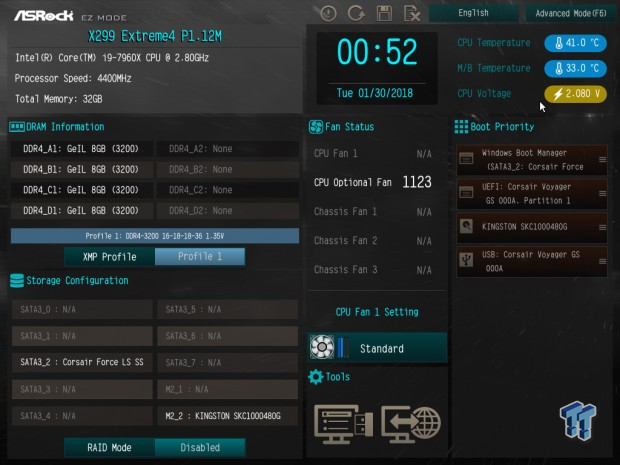
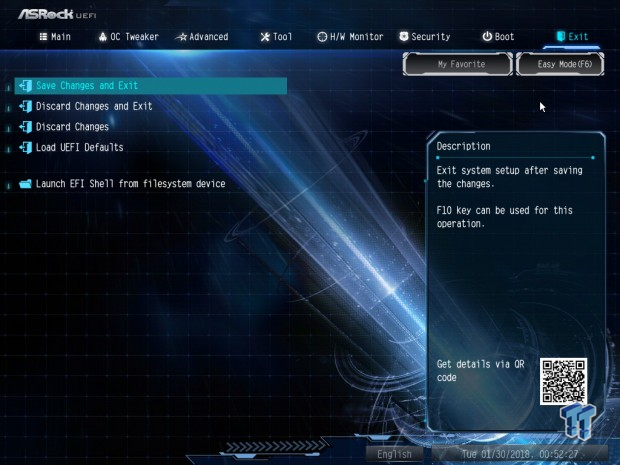

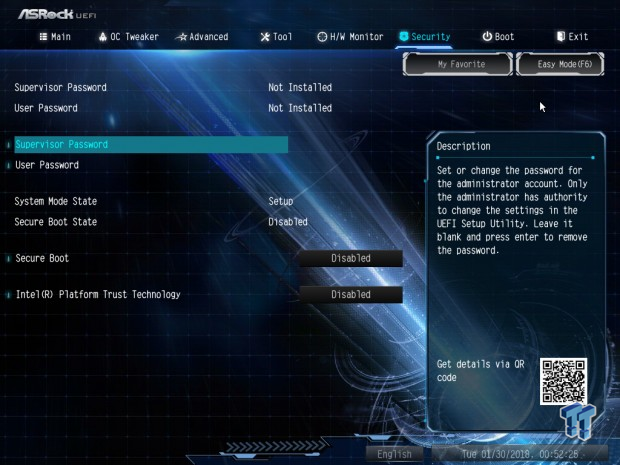
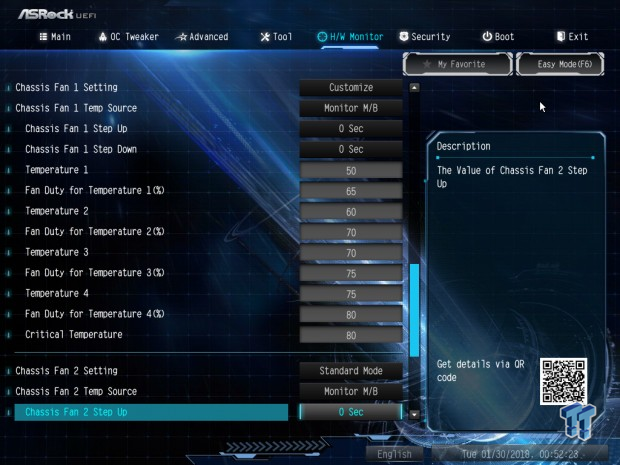
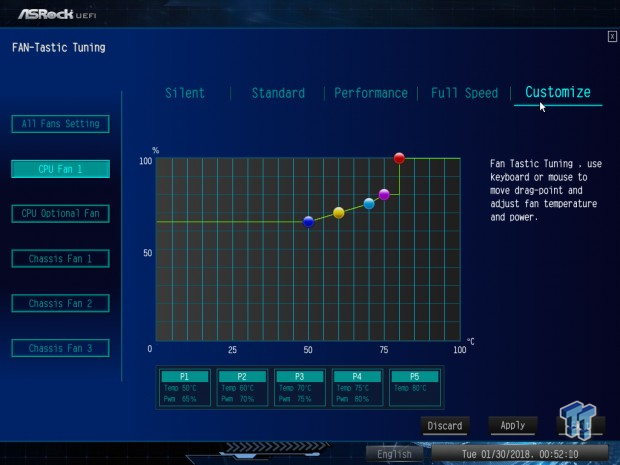

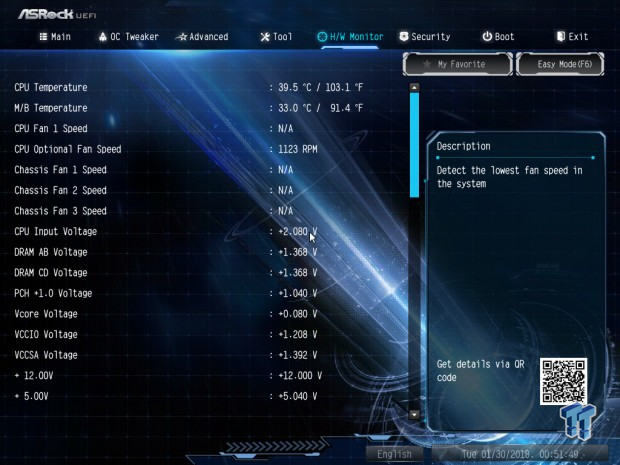
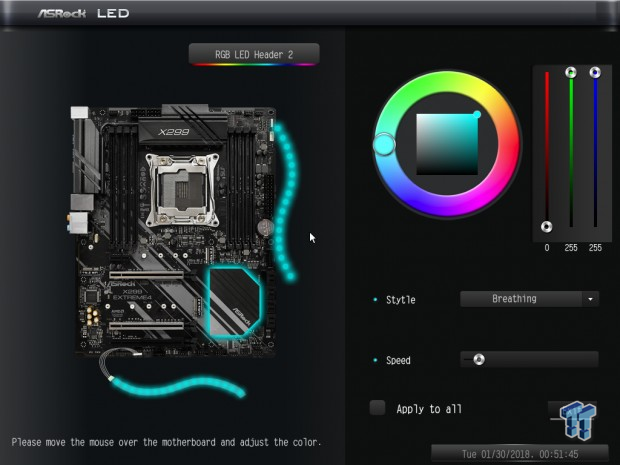
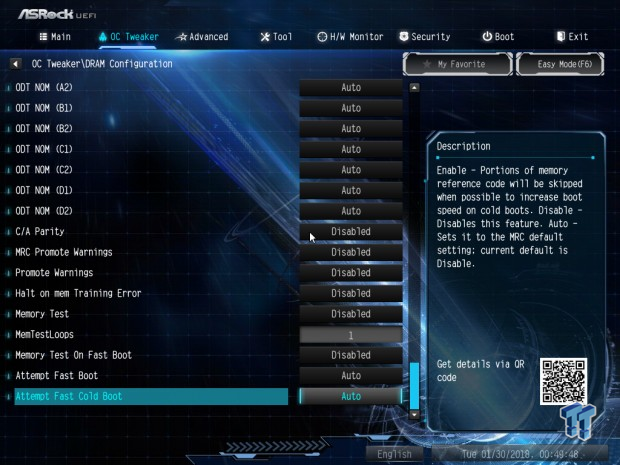
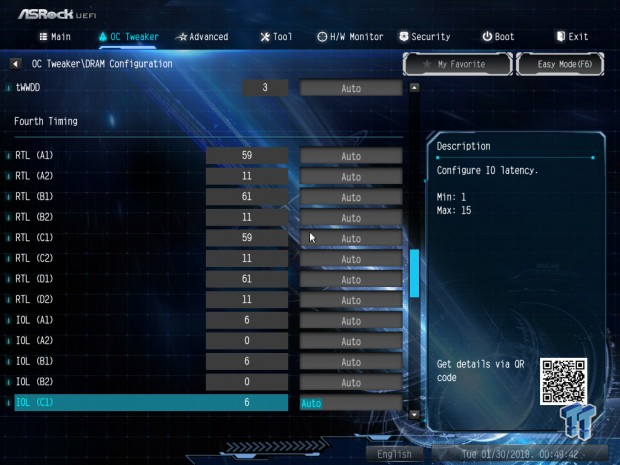
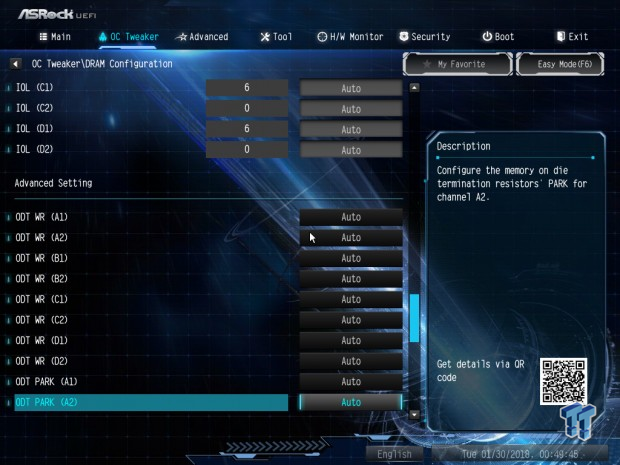

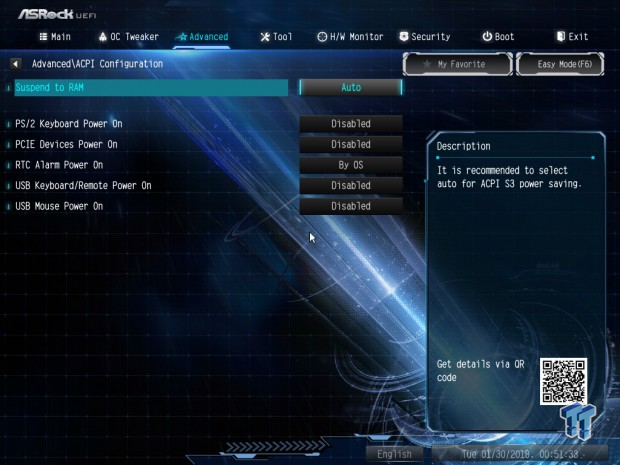
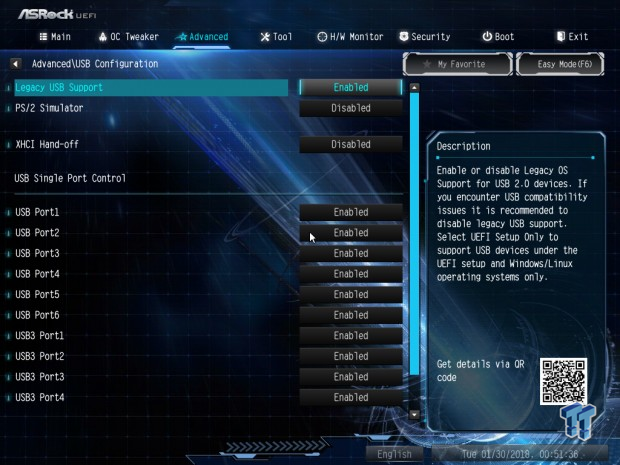
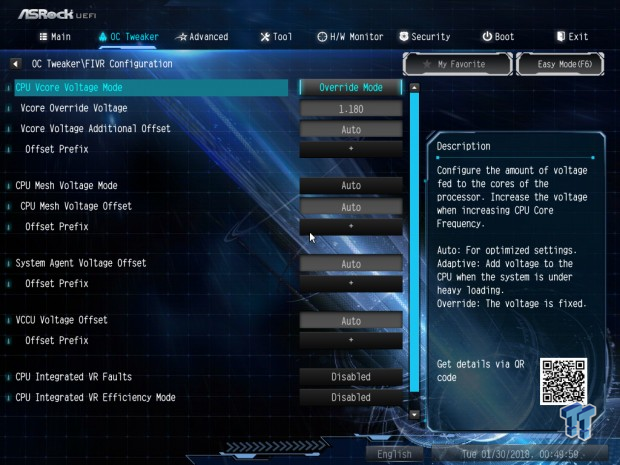
Software
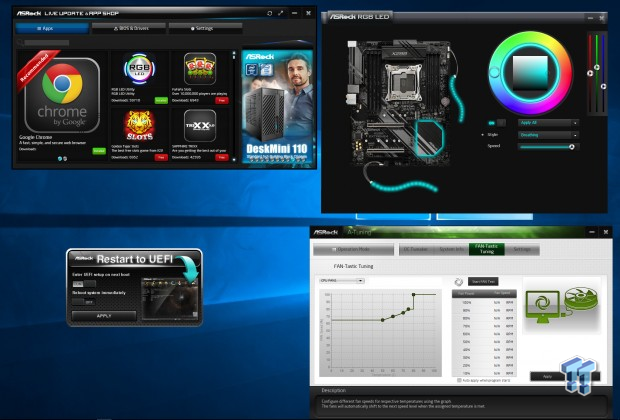
Software includes ASRock RGB LED, A-Tuning where you do fan control and overclocking, Restart to UEFI, and ASRock's Live Update and APP Shop.
Test System Setup
Steven's Motherboard Test System Specifications
- Motherboard: ASRock X299 Extreme4
- CPU: Intel Core i9-7960X
- Cooler: Corsair H110i - Buy from Amazon
- Memory: G.Skill TridentZ RGB (4x8GB) 3600MHz
- Video Card: NVIDIA GeForce GTX 1080 Ti FE - Buy from Amazon / Read our review
- Storage - Boot Drive: Corsair LS 240GB
- Storage - M.2 Drive: Kingston KC1000 480GB / Read our review
- Storage - USB Drive: Corsair Voyager GS 64GB - Buy from Amazon / Read our review
- Case: Corsair Obsidian 900D - Buy from Amazon / Read our review
- Power Supply: Corsair RM1000 - Buy from Amazon / Read our review
- OS: Microsoft Windows 10 - Buy from Amazon
- Monitor: ASRock PA328 ProArt 32" 4K - Buy from Amazon
- Keyboard: Corsair K70 LUX - Buy from Amazon
- Mouse: Corsair M65 PRO RGB - Buy from Amazon / Read our review
- Headset: Corsair VOID RGB Wireless - Buy from Amazon / Read our review
- BIOS: P1.12M
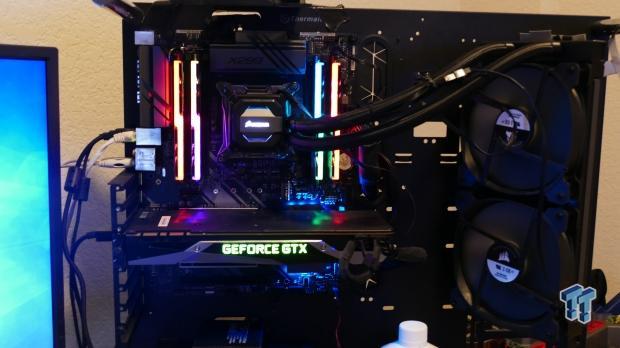
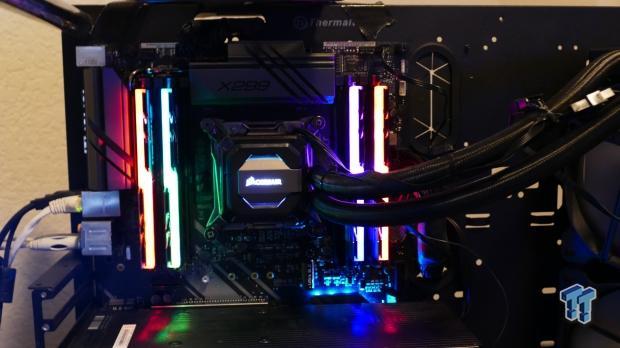

The RGB LEDs under the PCH are the only RGB LEDs built into the Extreme 4, which is great for those who don't want a lot of RGB LED lighting. You do get an RGB LED header in case you want to add lighting.
Overclocking
Overclocking Results
CPU Overclocking
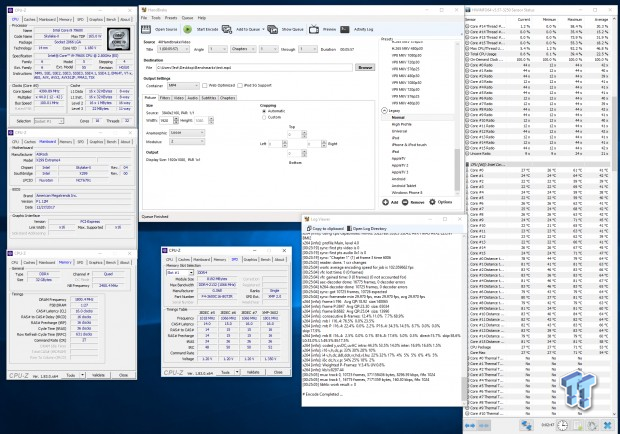
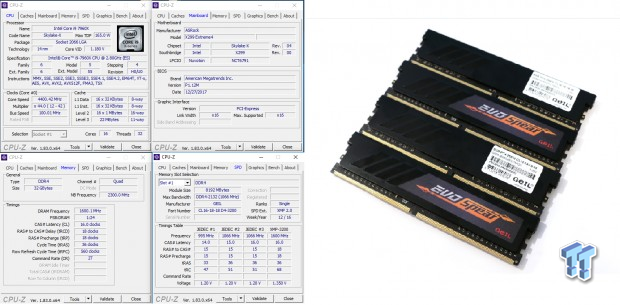
We set the CPU to 4.4GHz, the input voltage to 2.1v with LLC mode 2, VCore to 1.185v, and then XMP to enable. The frequency will go up and down unless you disable C-states in the UEFI. The motherboard handled the overclock like a champ. We do test with one G.Skill TridentZ kit, but we also have a 3200Mhz GEIL kit that worked like a charm as well.
CPU, Memory, and System Benchmarks
CINEBENCH R15
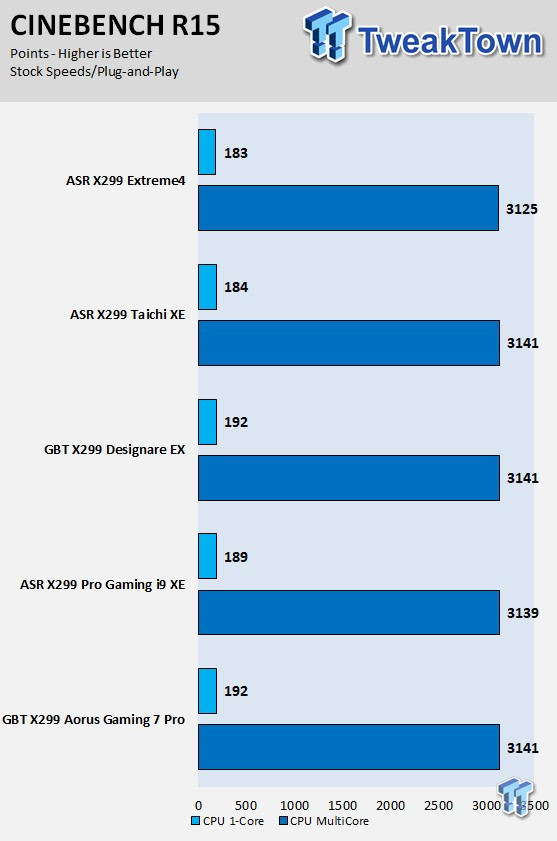
wPrime
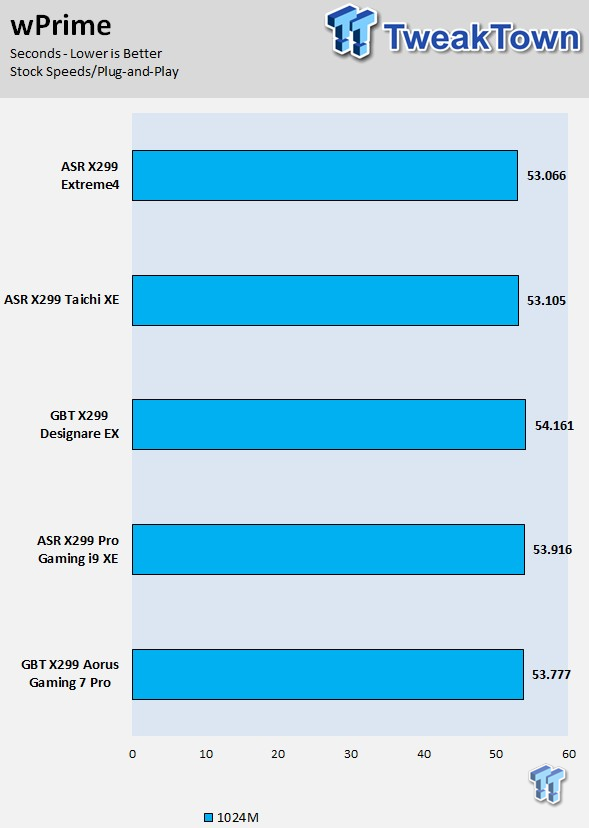
AIDA64 FPU
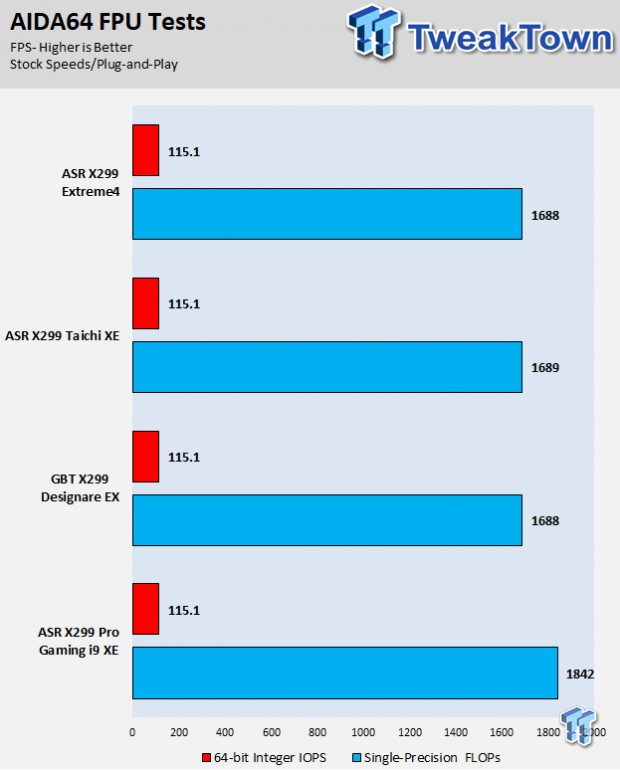
AIDA64 Memory
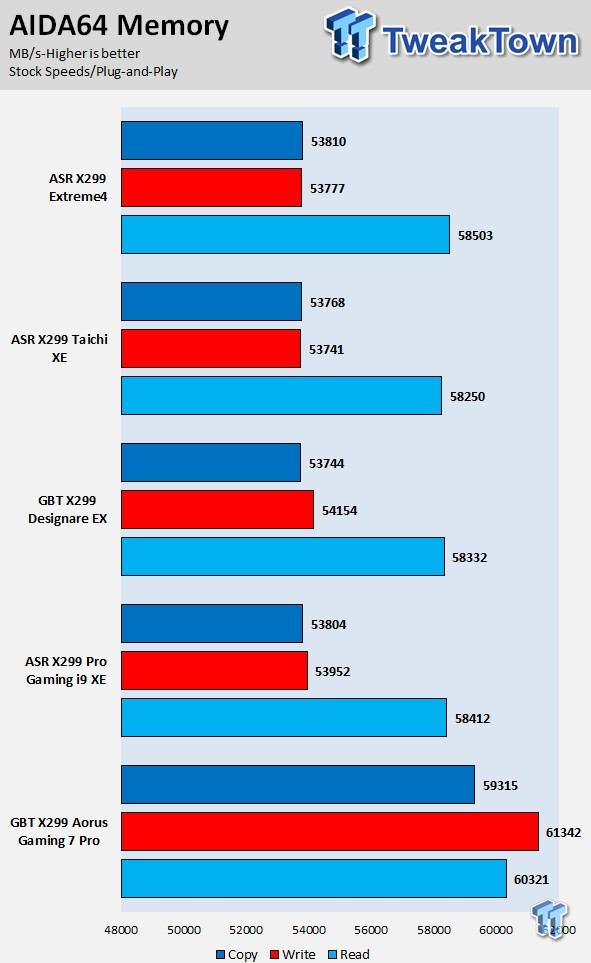
ScienceMark

HandBrake
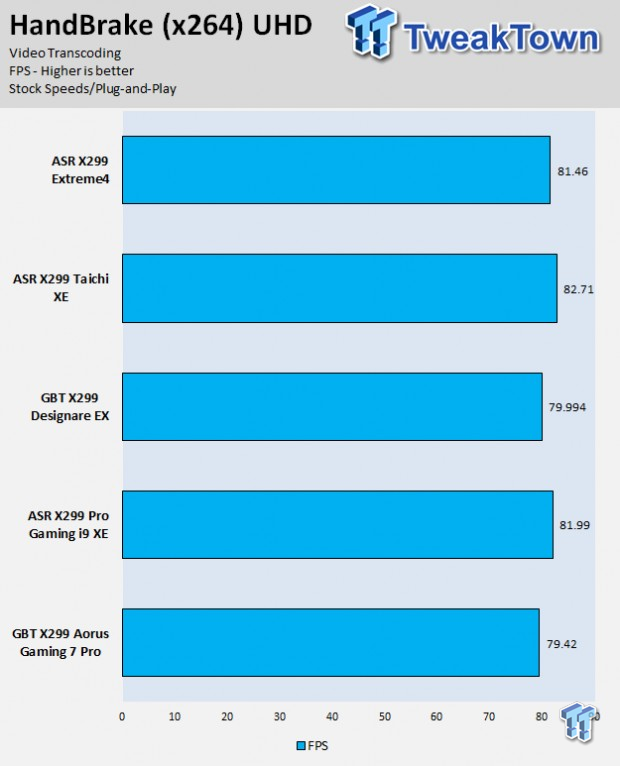
SuperPi 32M
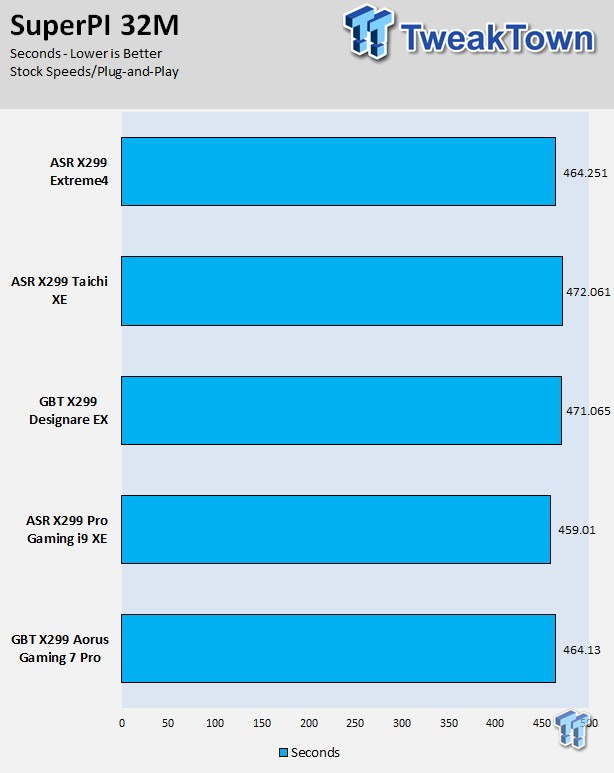
3DMark: Fire Strike

3DMark: Cloud Gate
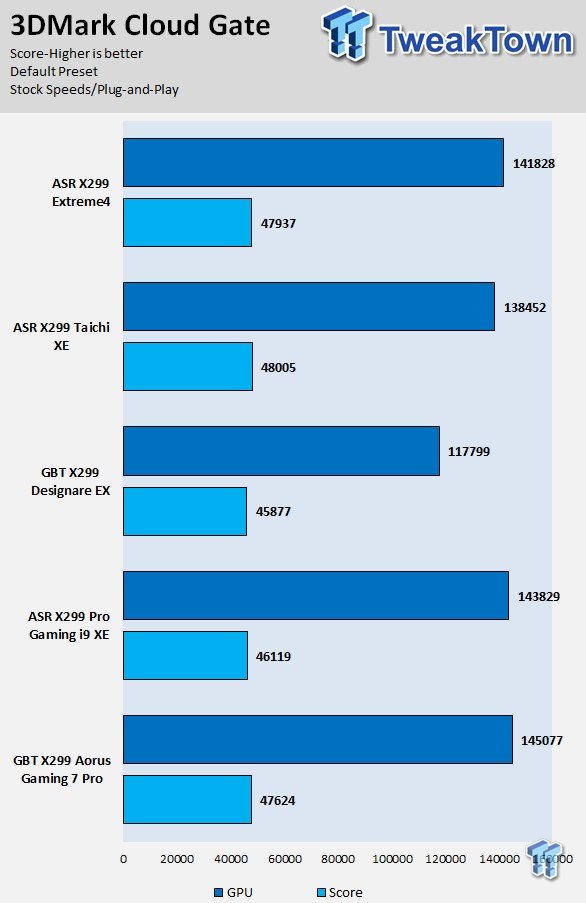
ResidentEvil 6
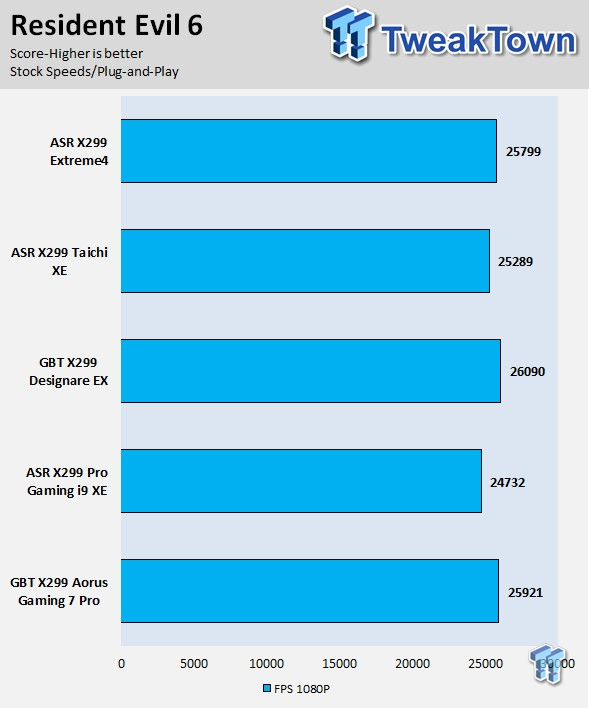
The ASRock X299 Extreme4 is performing admirably without issue and without multi-core enhancement enabled by default. I personally don't too much too much credence into benchmarking the CPU or GPU to see how well the motherboard does, as the difference is almost always within the margin of error. These tests are to make sure performance isn't below that margin, or to see what's going on if it's above.
System IO Benchmarks
CrystalDiskMark SATA6G:
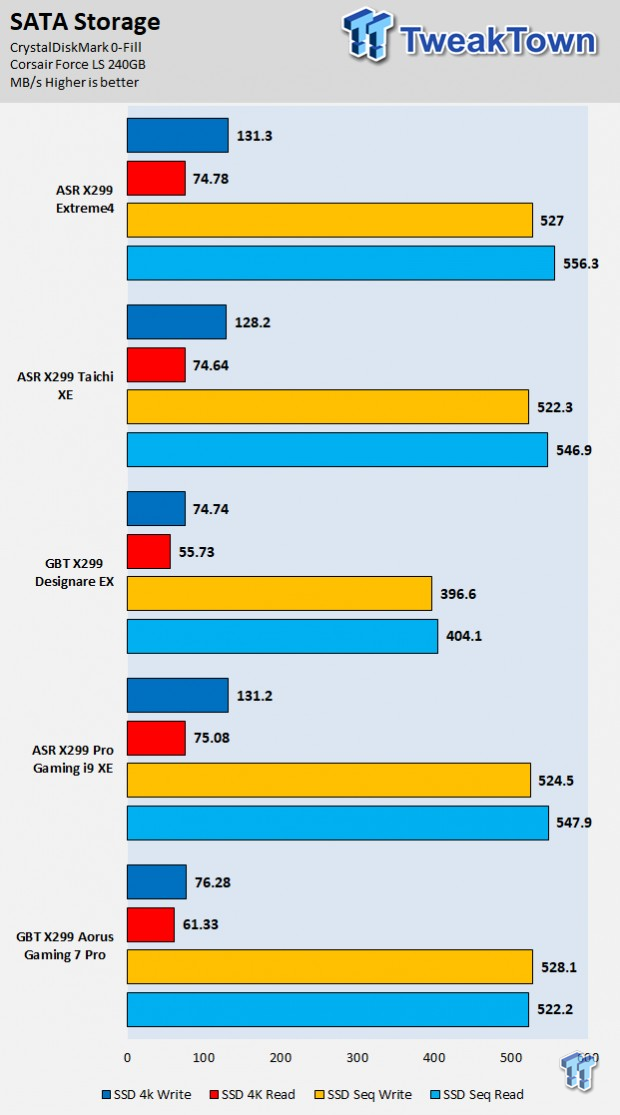
CrystalDiskMark M.2:
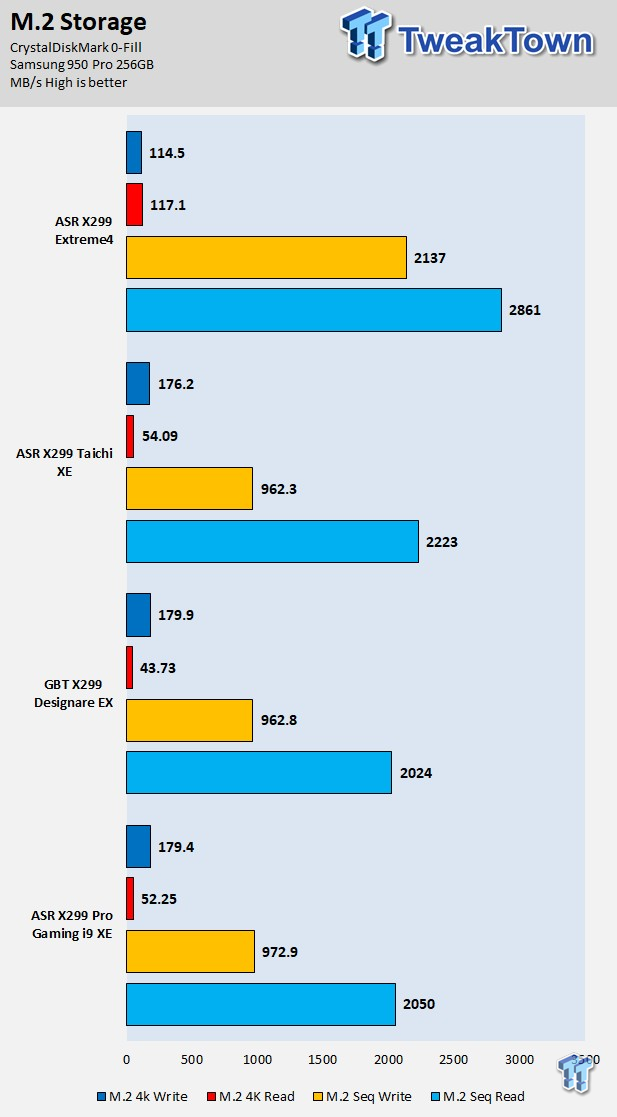
ixChariot Network Throughput:
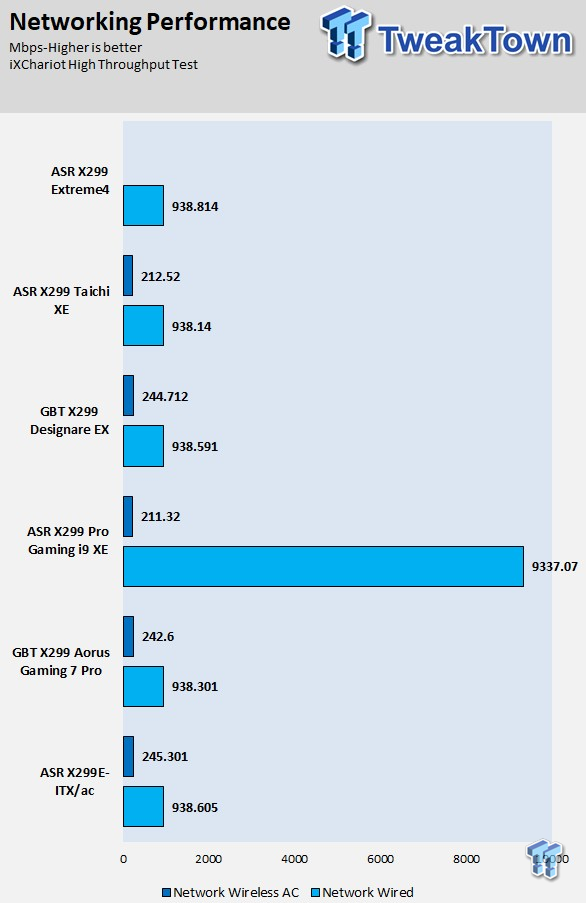
The ASRock's X299 Extreme4's SATA performance is excellent, M.2 performance is excellent with our new KC1000 M.2 drive, and networking performance is excellent.
Audio RMAA 5.5:
I disable all audio features, set the correct bitrates, and then test the audio with a loopback test.
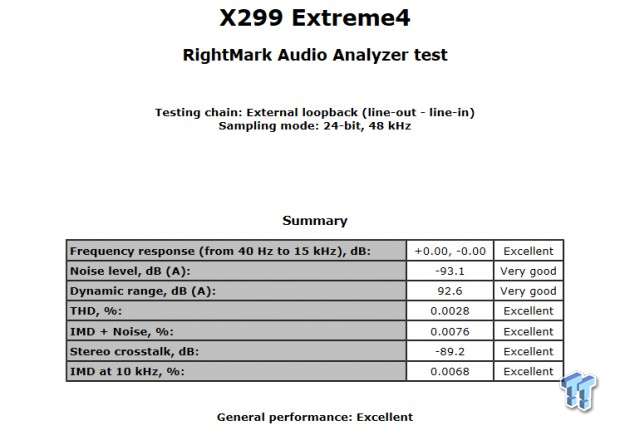
Sound Judgment by Ear: Excellent, a very clean ALC1220 can be found on this motherboard. There are five ratings for audio: 1. Problems, 2. Okay, 3. Acceptable, 4. Very good, 5. Excellent
VRM and System Thermal Imaging and Power Consumption
System power is measured at the wall with an AC power meter.
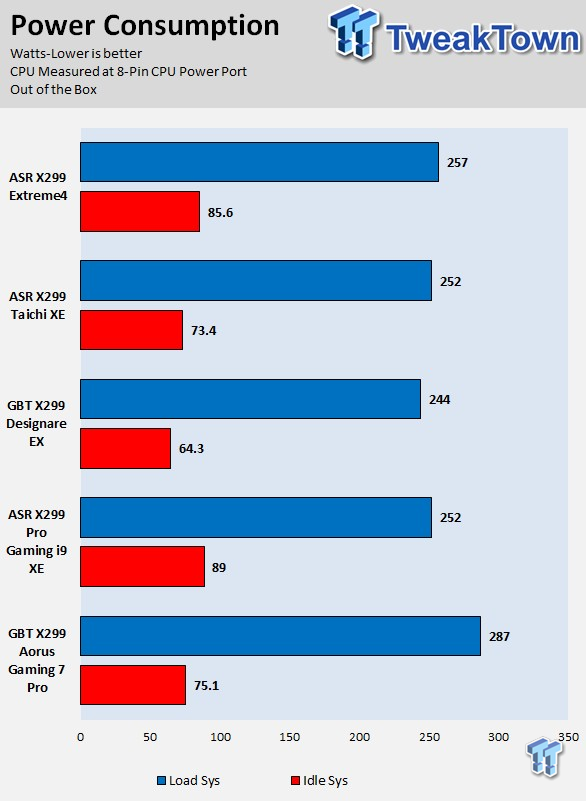
Note on Thermal Images: In the temperature section, we use our Seek thermal imaging camera to capture the surface temperatures of major components on the board. I look at the VRM and then all other things that light up the screen. If there is something to worry about, then I will state it. Otherwise, I will just show the hotter running parts of the board for fun. Unless some component is over 80-90C, then there isn't anything to worry about.
All systems will act differently, so I will look for commonalities, such as how far from the VRM the heat spreads through the PCB and the difference in temperature between the front side and backside of the PCB. Keep in mind, the majority of the heat from the VRM goes into the PCB as it is a giant soldered on copper heat sink. A larger difference in temperature between the back and front of the PCB points towards a more effective heat sink.
Thermal Testing at Stock Speeds:
The image on the left is always at idle, and the image on the right is at load. During ALL TESTS, fans above the VRM that cool the CPU cooler's (Corsair H110i) radiator are turned on to high (12v).
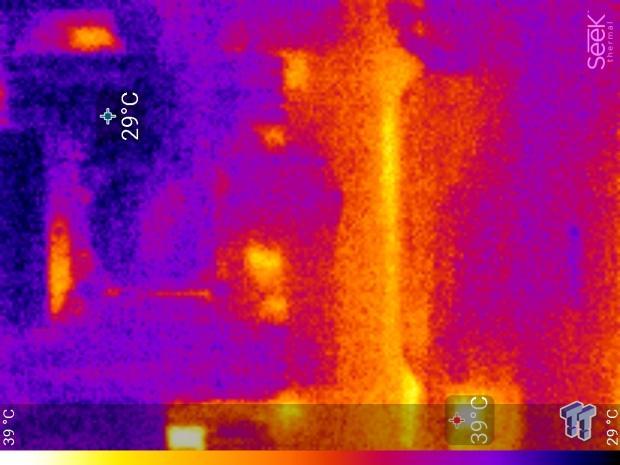

Full frontal.
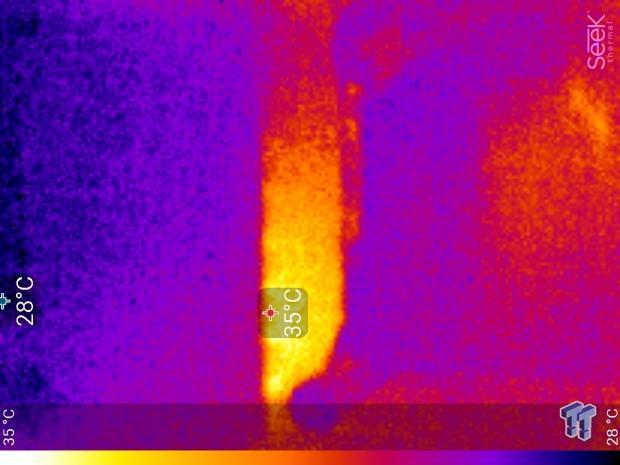
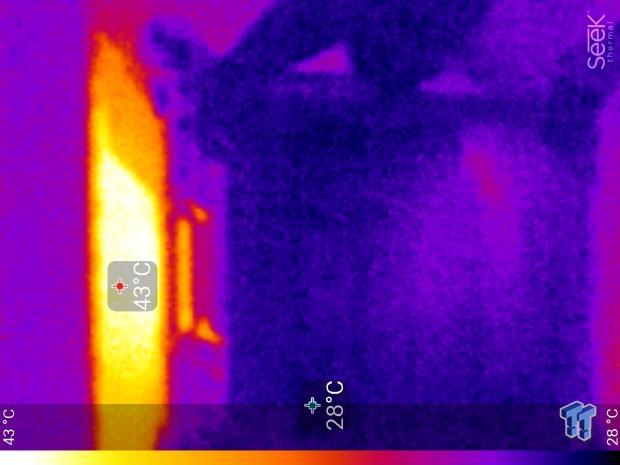
Up-close of the front of the VRM.
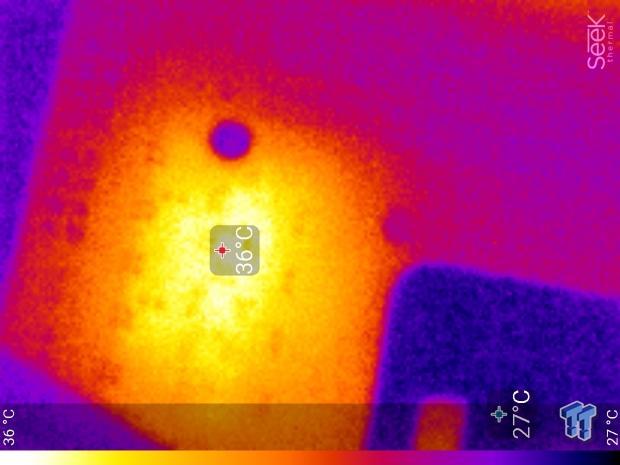
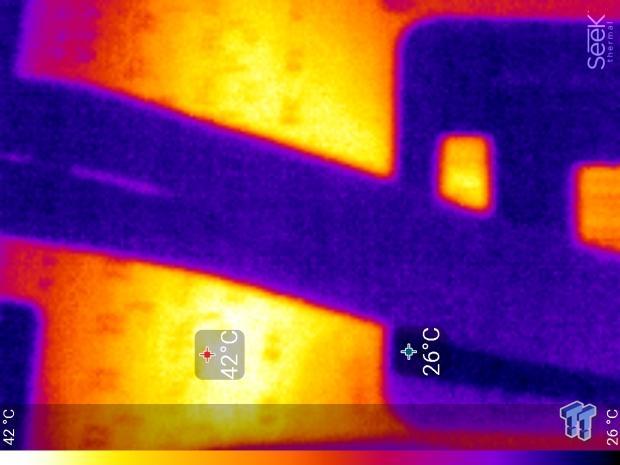
Up-close of the back of the VRM.
4.4GHz 2.1V VCCIN OCed VRM Thermal Imaging:
We standardize this test with a 4.9GHz on all cores with 1.2V real under load and take pictures at the 80% mark of HandBrake rendering a 4K video.
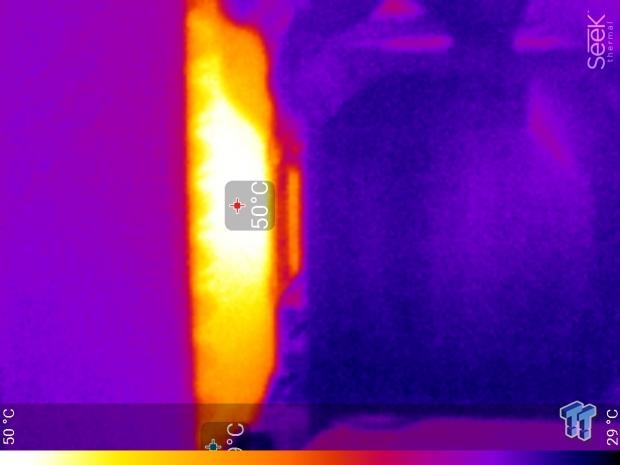
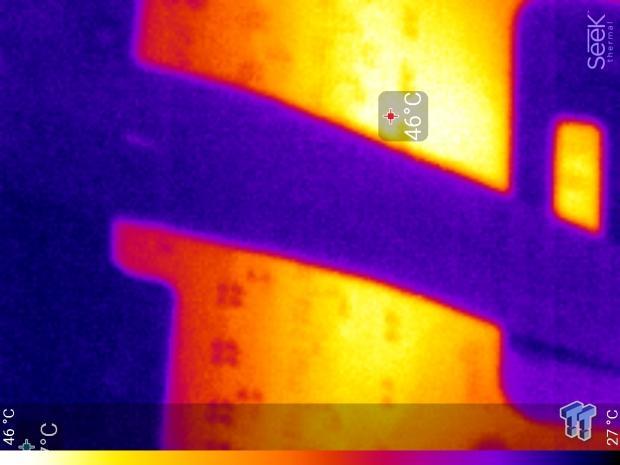
While this motherboard doesn't use the Intersil power stages, it does use the Intersil VRM that features great phase balancing with light loads. At full load, things seem balanced as well. These results are actually very good for this VRM, and that is because of the huge VRM heat sink with active airflow.
What's Hot, What's Not & Final Thoughts
Here are key points about the ASRock X299 Extreme4.
What's Hot
Value: There are really no questions or uncertainties about it, the X299 Extreme4 is the most affordable X299 motherboard on the market. The good news is that you still get solid controllers at the price point and USB 3.1.
VRM Heatsinks: ASRock made sure to launch this motherboard after their initial onslaught of X299 motherboard, and they did well by waiting. During the first round of X299 motherboards, it became clear that HCC CPUs would require better VRMs or much better VRM cooling. The X299 Extreme4 offers significantly better VRM cooling, with heat sinks almost as heavy as the entire motherboard.
Solid Controllers: When vendors typically cut the price of a product they also cut down 3rd party IC quality, but not here. In this case, ASRock maintained the same high-quality controllers, such as the ALC1220, ASM3142, and Intel i219 PHY.
Easy to Understand PCI-E Slots: The PCI-E layout is really simple, and that way users won't have issues figuring out how much bandwidth each slot will receive.
What's Not
Two M.2: Most X299 motherboards feature three M.2 slots, but the Extreme4 only has two. It's a very small issue, but that's because I couldn't really find many others with the motherboard.
Final Thoughts
ASRock's X299 Extreme4 is the most affordable X299 motherboard. We even went over to Newegg to check out its price versus other motherboards, and it is even less expensive than open-box motherboards. While it's just roughly $10 less than other comparable X299 motherboards, it does come with enhancements that only come with second-round X299 motherboards.
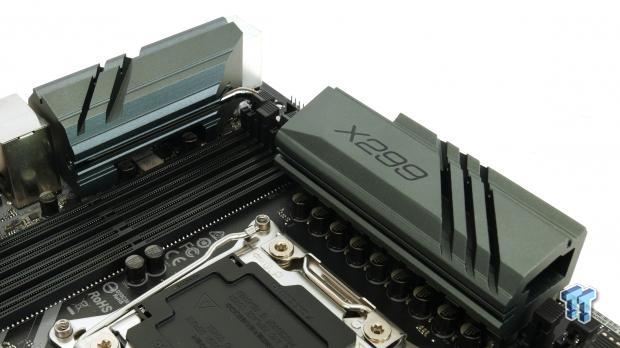
That includes a much better VRM heat sink, and better power delivery support. The X299 Extreme4 also carries all the latest features you might want such as USB 3.1 and solid audio, so you really aren't missing out on much. If you don't like the idea of over-spending on an X299, but still want solid features, the X299 Extreme4 should definitely be considered.

| Performance | 92% |
| Quality | 90% |
| Features | 91% |
| Value | 98% |
| Overall | 93% |
The Bottom Line: The solid ASRock X299 Extreme4 is one of the most pocket-friendly yet capable X299 motherboards on the market, and pairs well with Intel's HCC CPUs.
PRICING: You can find products similar to this one for sale below.
 United
States: Find other tech and computer products like this
over at Amazon.com
United
States: Find other tech and computer products like this
over at Amazon.com
 United
Kingdom: Find other tech and computer products like this
over at Amazon.co.uk
United
Kingdom: Find other tech and computer products like this
over at Amazon.co.uk
 Australia:
Find other tech and computer products like this over at Amazon.com.au
Australia:
Find other tech and computer products like this over at Amazon.com.au
 Canada:
Find other tech and computer products like this over at Amazon.ca
Canada:
Find other tech and computer products like this over at Amazon.ca
 Deutschland:
Finde andere Technik- und Computerprodukte wie dieses auf Amazon.de
Deutschland:
Finde andere Technik- und Computerprodukte wie dieses auf Amazon.de
Similar Content
Related Tags
